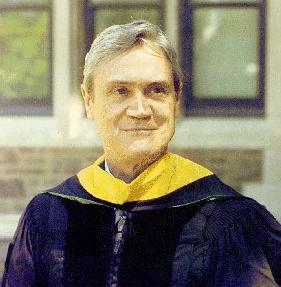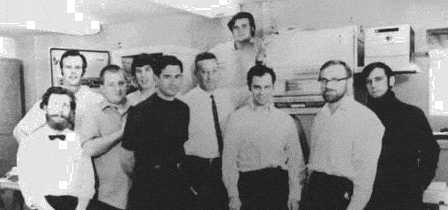 – Wesley Clark |
|
 – Widely circulated photo of the IMP Team (L to R): Truett Thatch, Bill Bartell (Honeywell), Dave Walden, Jim Geisman, Robert Kahn, Frank Heart, Ben Barker, Marty Thrope, Will Crowther, Severo Ornstein. Not pictured: Bernie Cosell. |
The Interface Message Processor provided a system independent interface to the ARPANET that could be used by any computer system, thereby opening the Internet network architecture from the very beginning.
The idea for the Interface Message Processor (IMP) was suggested by Wesley Clark at the “ARPANET Design Session” held by Lawrence Roberts at the IPTO Principal Investigator meeting in Ann Arbor, Michigan in April, 1967. Roberts’ plan called for each site to write the software to connect their computer to the network, which looked like a lot of work to the attendees since there were so many different kinds of computers and operating systems in use throughout the DARPA community. Clark told Roberts that he thought the design was inside out. After the meeting Roberts stayed behind and Clark elaborated on his concept — deploy a minicomputer called an “interface message processor” at each site to handle the interface to the ARPANET network, so each site would only have to write one interface to the one standard IMP.
At the end of 1967, DARPA gave the Stanford Research Institute (SRI) a contract to write detailed specifications describing the ARPANET communications network. SRI finished their report, titled “A Study of Computer Network Design Parameters”, in early 1968. Lawrence Roberts and Barry Wessler used this report to write a final version of the IMP specification, describing communications standards for different computers, and presented it at the DARPA Principal Investigators meeting in June, 1968.
In July, 1968, the IPTO sent a Request For Quotation for the development of an Interface Message Processor to 140 companies. In December, 1968, DARPA awarded a contract for development of the IMP to the consulting company Bolt Beranek and Newman (BBN), which J.C.R. Licklider had worked for years earlier. Because they were based in Cambridge in his home state of Massachusetts, then Senator Ted Kennedy sent BBN a well-meaning but slightly confused telegram of congratulations for winning a contract to develop an “interfaith message processor”.
The team that developed the IMP was led by Frank Heart, and included Robert Kahn as the communications theoretician (later helped develop TCP/IP), Severo Ornstein in charge of hardware (later founded Computer Professionals for Social Responsibility), Ben Barker helping with hardware, and a programming team consisting of Will Crowther (who later developed the first adventure game), Dave Walden, and Bernie Cosell. The requirements specification development was led by Kahn and released as specification #1822 in April, 1969.
Dave Walden provides an interesting first-hand retrospective of the IMP and early ARPANET here.